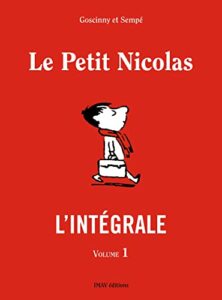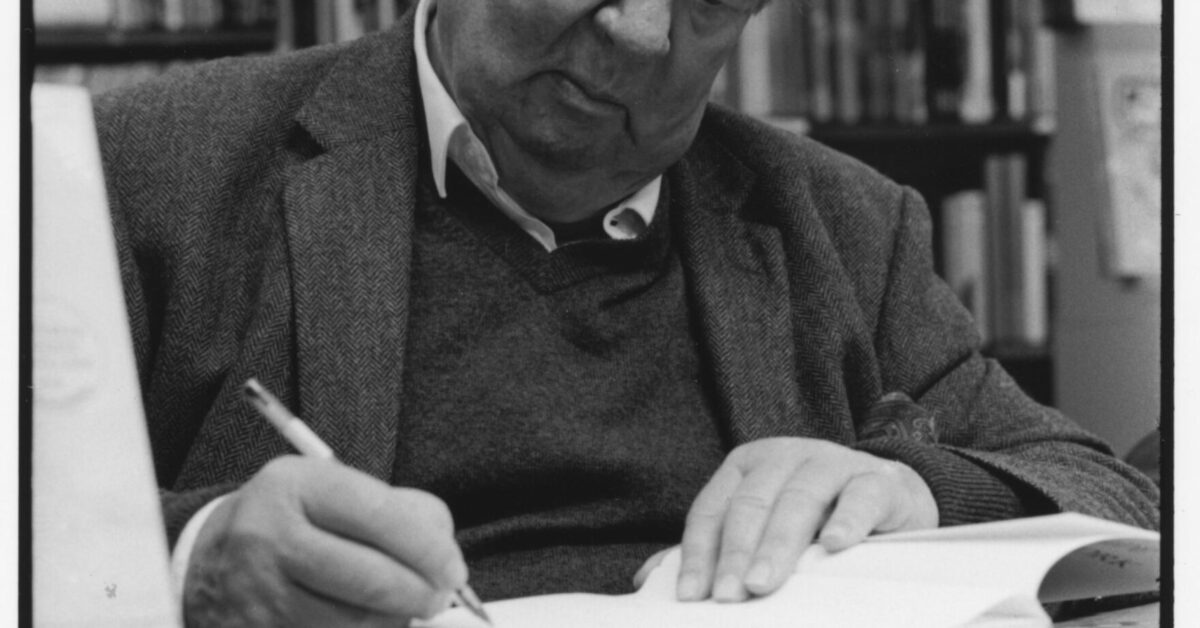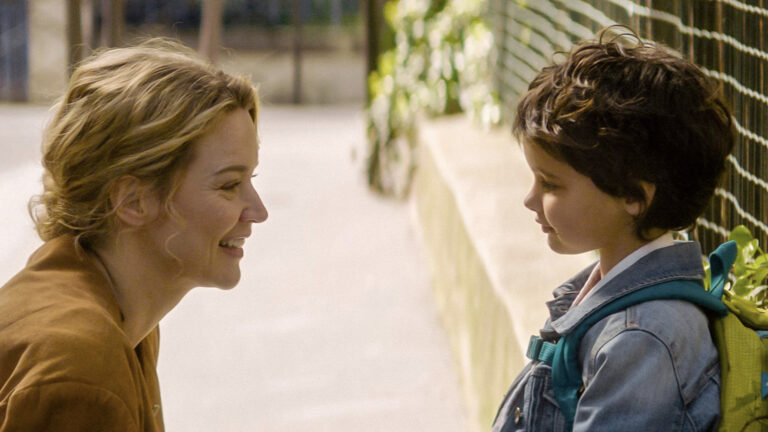Many people know Sempé, even if they don’t know they know Sempé. For one, they probably have seen his New Yorker cartoons and covers, which he first began to pen in 1978. For the covers, his whimsical lines had an inside/out or upstairs/downstairs quality that was at once poignant and also funny, tickling some unknowable place inside us that felt at once moved and also understood. The reporter Robert McFadden described this quality of Sempé’s drawings in his obituary for the artist on August 11, 2022 in The New York Times as “…portraying gentle people with big noses at poignant moments.”
For example, there was one especially memorable cover of modern dancers on a stage in blue and red leotards, while unseen workmen in blue uniforms with red hats pull the ropes, push levers, turn on lights and and haul set pieces backstage, their gestures replicating the graceful movements of the stars on stage. And Sempé made many of cats (and people) inside their apartments looking out their windows at a myriad of lives going on inside other little squares in other apartments; sort of Hopper-esque, but with more of a contented humor than loneliness. And bikes, he loved bikes (and biking!) –people riding them in the countryside in France or through crowded cityscapes or taking bikes a little too seriously. Like this one, below, of a shop full of bikes, and a man all dressed in his Lance Armstrong gear patiently waiting for his bike to get fine-tuned enough that he can take off.
Many children (especially French children, for sure) can take one look at an image of Sempé’s Nicolas, a messy-haired boy of around six years old, and they will say, “Oh yeah, that’s Nicholas.”
Jean-Jacques Sempé created Nicolas with his friend (and Asterix creator) René Goscinny and together they published a comic strip that was first published in 1956 in a Belgian newspaper, Le Moustique, which went on to become 16 books in total published under the series title, Le Petit Nicolas, or Little Nicholas, in English. 
But the stories were not necessarily drawn from Sempé and Goscinny’s own carefree, idyllic and silly childhoods. Both Goscinny and Sempé had difficult early lives. Goscinny was the son of Jewish parents from Ukraine and he and his family left France for Argentina when he was two and was raised in Argentina, where his father was helping Jewish refugees escape pograms in Eastern Europe and resettle in Argentina. At first, their lives were good in Argentina, where Goscinny and his brother attended a French school. But then his father died, unexpectedly, and the Second World War erupted in Europe and his mother could not return to France with her sons for fear they would be captured and deported. On the other side of the earth, Goscinny, his mother and brother were helpless while the rest of their family–grandparents, uncles, aunts and cousins–were captured and never heard from again. There was nothing they could do.
Sempé, on the other hand, was born near Bordeaux to a single mother who eventually married his step father who was an alcoholic. He was beaten and neglected at home, he later said. After being expelled from school he found a job selling tooth powder and then delivering wine by bicycle. In 1950, he joined the army, after lying about his age, because, he said, “it was the only place that would give me a job and a bed.” He got in trouble frequently while in the army for drawing and was eventually discharged when they discovered he was too young to serve. He moved to Paris and met Goscinny who was already having some success as a writer and illustrator. Goscinny became a friend, mentor, and collaborator.
What the two men then created, together, was the comic of “Petit Nicolas,” whose childhood was one they both wished they had had. Through Nicolas the two men were able to pour the good parts of their childhoods into this small, funny boy, and also re-envision the bad parts, turning them joyful. In this way, together, they were able to overcome some of the trauma of their own childhoods.
Now a new animated movie called, Little Nicholas: Happy as Can Be, made by Amandine Fredon and Benjamin Massoubre, tells the story of Sempé and Goscinny’s devoted friendship and their creation of Petit Nicolas. As much a moving story about their relationship, it’s also the inspiring story of two people devoted to their craft. And the movie shows, in lush watercolor and ink drawings, how important the creation of Petit Nicolas was to both of them. As the character of Sempé says at one point to the muse of “Little Nicholas” in his minds eye, “Thanks to you, I’m finally having a childhood.”
Goscinny died of a heart attack when he was only 51, in the middle of a stress test at his doctor’s office, which was a terrible blow to Sempé; he mourned the loss of his friend for the rest of his life. Sempé himself lived until he was 89, dying last August six days before his 90th birthday.
But the movie, though it does mention Goscinny’s death and Sempé’s grief, is more a celebration of the triumph of art to heal and connect than anything else. It is a film for the entire family and will inspire both the young and old amongst us.
Don’t just take it from me: I watched it with my eight-year-old son, who loves to draw. As he watched he was giggling and repeating words like “chouette” and “rigole” and laughing about the scenes where Nicolas and his friends don’t want to play with a girl. and As soon as it was over, he was at his own desk, drawing characters. He said, “I thought it was really good because of all of the drawing. It inspired me.” Later, he told me he had been thinking about it all day long and can’t wait to read the Petit Nicolas books. This morning he wanted to talk again about how silly the part was with all the boys showing off for the girl they had said they didn’t want to play with. In other words, the movie and the garçon, Nicolas, are both indelible–they are with him forever.
At the end of the movie, the character of Nicolas, the muse, asks his creator what will happen when Sempé dies, too. Will their adventures together be over? And Sempé says, “We will live through you.” As any parent knows, our own mortality is a sure thing. The best we can hope for is that we live through our children, who will continue to light up the world, long after we are gone. Thanks to the sensitive wisdom of this film, the expansive spirts of Sempé and Goscinny will stay with me, too, for as long as I stomp around this mortal coil.
Little Nicholas: Happy as Can Be has been nominated for a César award and took top honors at the Annecy International Animation Film festival in France last summer. It will premier tonight in New York City at the Animation First Festival presented by the French Institute Alliance Française. FIAF says that the film “is presented in conjunction with the FIAF Gallery exhibition: Signature Sempé. The exhibition will consist of a selection of Sempé’s most iconic works, including quintessential drawings from Le Petit Nicolas and New Yorker cover designs and will run until April 7th. On Saturday, January 28 there will be a conversation with the Little Nicholas filmmakers, gallerist Martine Gossieaux, and New Yorker artistic director Françoise Mouly examining the allure and longevity of Sempé and Le Petit Nicolas.”
Find Little Nicholas: Happy as Can Be soon in a theatre near you. You won’t regret those 85 minutes of pure joy.
Caitlin Shetterly is the Editor-in-Chief of Frenchly. She is also the author of 4 books: Fault Lines, Made for You and Me, Modified and the upcoming novel, Pete and Alice in Maine, which will be published on July 4th, 2023 by Harper Books. She is a native daughter and she lives with her two sons and husband in an old house on the coast of Maine.
Top photo credit: Olivier Meyer.








